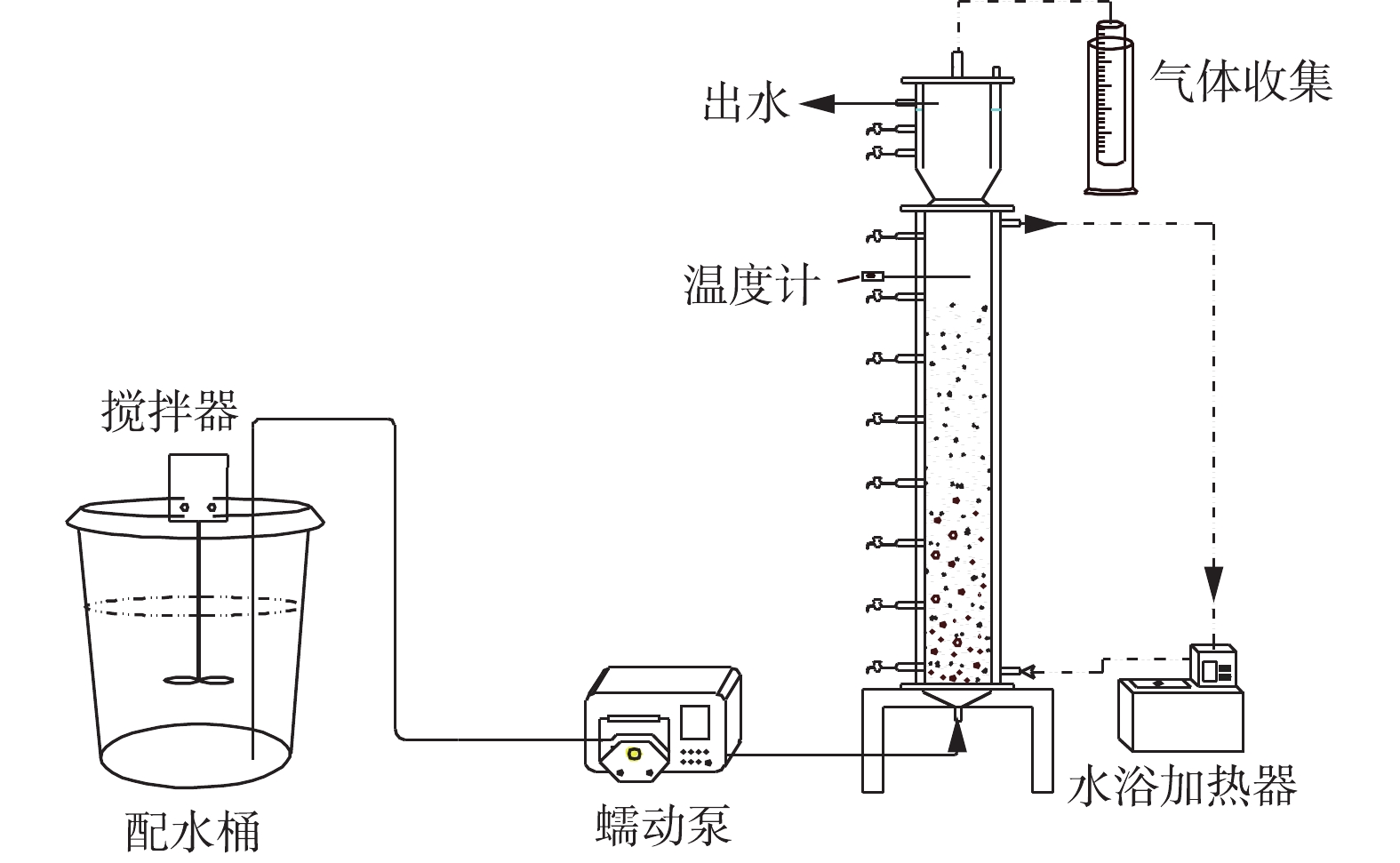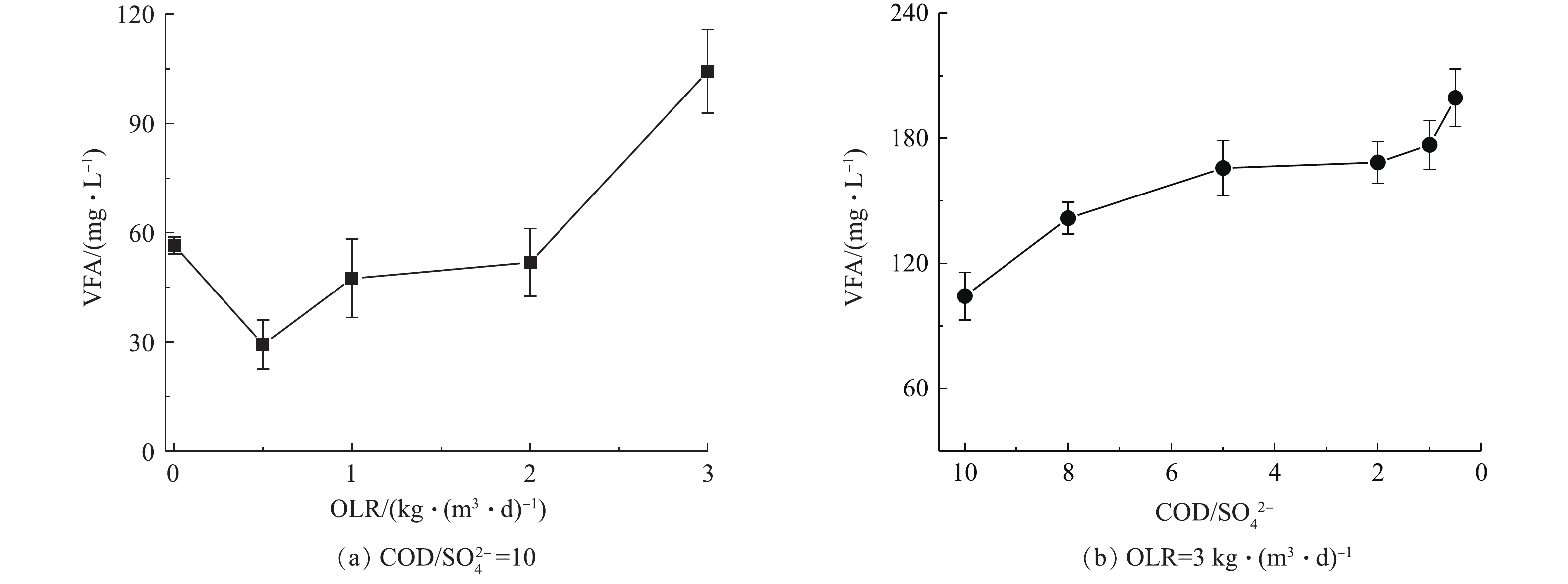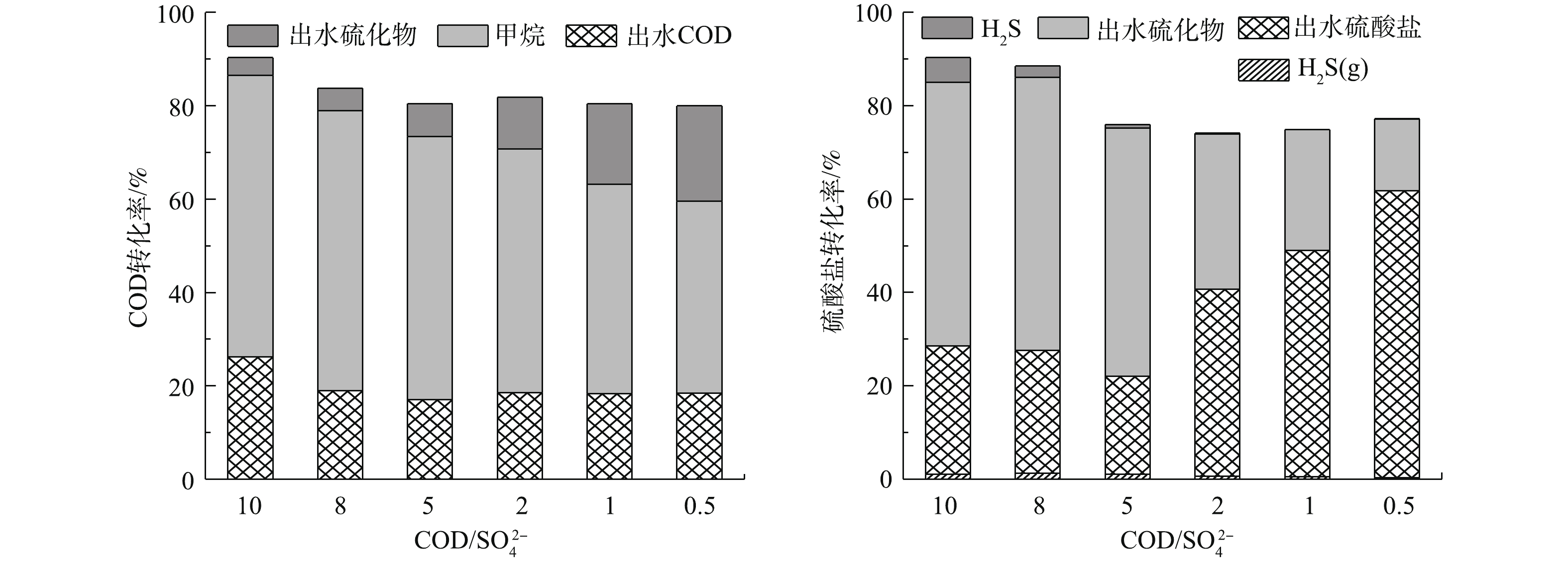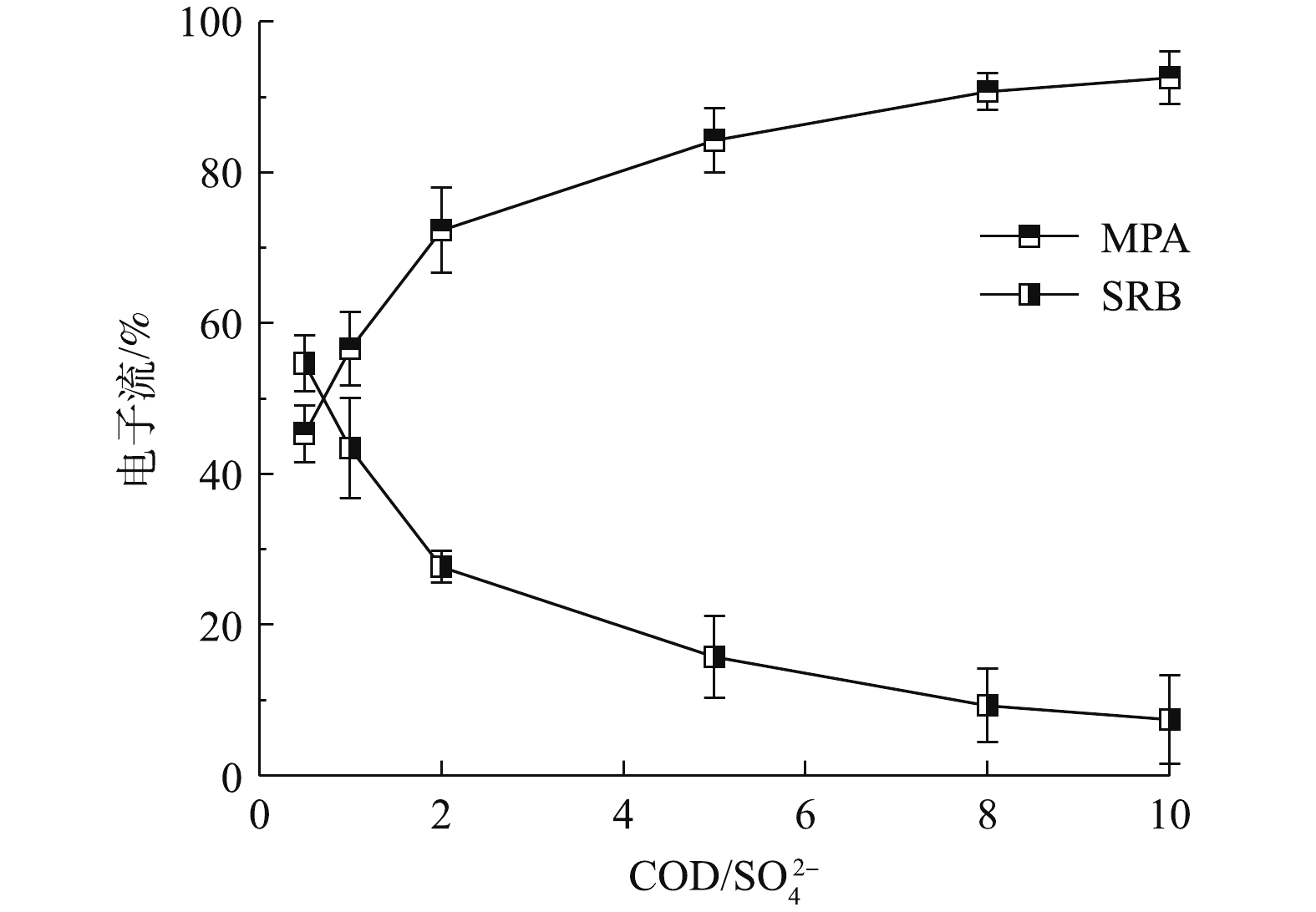-
由于厌氧生物技术具有低能耗、可回收甲烷以及污泥产量低等优点,常作为高浓度有机废水处理的首选工艺。然而,在一些化工合成材料和医药中间体生产过程中由于大量硫酸的使用,使得废水具有高硫碳比的特点。对于这类废水如果使用厌氧生物处理技术,由于硫酸盐还原菌(SRB)与产甲烷菌(MPA)的竞争生长,会产生大量还原态硫,这会带来2个问题:一是硫化氢会对产甲烷菌的活性产生抑制作用,往往致使系统失稳甚至崩溃;二是处理过程中产生的沼气由于硫化氢含量高,从而导致后期气体净化成本大幅增加[1-2]。为此,有学者尝试在处理系统中添加SRB的抑制剂(钼酸盐),抑制H2S的产生,但钼酸盐同时也抑制了MPA,且随着SRB的逐渐驯化,这种抑制作用逐渐减弱[3]。而添加铁盐或铝盐形成硫化物沉淀,也可以减轻H2S对MPA的抑制毒性[4-6],但系统运行费用会显著增加,而且产生的大量沉淀物如何有效处理也是一个难题。一般认为,游离的分子态H2S的抑制行为是硫化物抑制MPA活性的主要作用形式[7],而硫化物浓度受pH的波动变化较大(pH=7.0,H2S约50%;pH>8.0,H2S低于10%)。因此,基于硫化物的存在形态随pH的变化而改变,提高反应器运行的pH,一方面可能会改善游离态H2S对MPA活性的毒性抑制,另一方面亦可减少沼气中H2S含量,为甲烷气体的利用提供便利。虽然有一些研究[8-10]表明,高pH (pH≥8.0)不利于常规MPA的生长代谢,会致使系统中的SRB成为优势菌种。但也有研究[11]发现,在人工或自然环境中存在着大量的嗜碱产甲烷菌,而且表现出较好的产甲烷活性。最早的一株嗜碱产甲烷杆菌是从沼气工程的厌氧污泥中分离得到的,其最适pH为7.5~8.5,在pH为 6.5~10.0时均可以生长。有研究[12-13]从不同的高碱性湖中分离得到嗜碱产甲烷八叠球菌LN1和嗜碱产甲烷八叠球菌NY-728,其在pH为6.5~9.5下均可生长,最适pH分别为8.9和8.1~8.7。这些嗜碱产甲烷菌的存在,就为高pH运行的厌氧产甲烷微生物体系的构建提供了可能。
鉴于此,本文搭建了一套pH为8.5的升流式厌氧污泥反应器(UASB),将其用于含高硫酸盐有机废水的处理,考察了不同运行条件下的系统净化性能,探究了高pH下MPA和SRB的竞争机制以及微生物群落结构演变特征,以期为厌氧生物系统在高pH运行下处理高含硫有机废水反应器的构建及调控提供一定的理论依据和数据支撑。
全文HTML
-
本研究反应装置如图1所示,反应器的有效容积为2.5 L,颗粒污泥体积占反应器有效体积约2/3,反应器双层壁连接水浴加热装置以将温度控制在(35±1) ℃,模拟废水通过蠕动泵从反应器底部进入系统。
反应器接种污泥取自江苏省徐州市某制药厂的UASB厌氧污泥罐,污泥初始混合悬浮物浓度(MLSS)和混合挥发性悬浮物浓度(MLVSS)分别为15.81 g·L−1和9.55 g·L−1,且具有良好的产甲烷性能。
-
反应器进水采用模拟废水,碳源和硫源分别由C6H12O6和Na2SO4提供。反应器整个运行期间,控制COD在2 000 mg·L−1,通过改变水力停留时间(HRT)控制系统有机负荷(OLR),通过调整Na2SO4的投加量以控制COD/
${\rm{SO}}_4^{2 - }$ 的比例。模拟废水中营养物质由K2HPO4、KH2PO4、NH4Cl和KCl组成。微量元素包括NiCl2·6H2O、CaCl2、MgCl2·H2O、FeCl2·4H2O和CoCl2·6H2O。利用Na2CO3和NaHCO3调控反应系统的pH=8.5。具体运行参数如表1所示。 -
1)常规指标。在整个反应装置运行期间,每2 d从反应器出水口取样对各指标分析测定,其中COD测试采用重铬酸钾法;
${\rm{SO}}_4^{2 - }$ 测试采用铬酸钡分光光度法;S2−测试采用N, N-二乙基对苯二胺分光光度法;挥发性有机酸(VFA)测试采用硫酸法;气体H2S浓度测试采用气体检测管,其中色谱的条件为GC 9790 Ⅱ,以N2为载气,进样口、检测器和聚四氟乙烯柱的运行温度分别为120、150 和120 ℃;用气密性注射器(400 μL, Agilent Syringe)以手动进样的方式进样。液体中游离H2S 浓度根据式(1)进行计算。
式中:
$ {C}_{{\mathrm{H}}_{2}\mathrm{S}} $ 为H2S浓度,mg·L−1;C硫化物为总硫化物浓度,mg·L−1;K1为H2S的第一电离常数。电子流计算:反应器中MPA和SRB的电子利用情况[14]通过式(2)和式(3)计算,结果均取3次平均值。
式中:
$ {K}_{1} $ 为MPA(产甲烷菌)的电子流占比;$ {K}_{2} $ 为SRB(硫酸盐还原菌)的电子流占比;$ {M}_{{\mathrm{C}\mathrm{H}}_{4}{\text{-}}\mathrm{C}\mathrm{O}\mathrm{D}} $ 为产生CH4所消耗的COD (产生CH4的摩尔数×64 g);$ {S}_{{\mathrm{H}}_{2}\mathrm{S}{\text{-}}\mathrm{C}\mathrm{O}\mathrm{D}} $ 是产生H2S所消耗的COD(产生H2S的摩尔数×64 g)。2)微生物群落多样性指标。待反应器第3阶段不同COD/
${\rm{SO}}_4^{2 - }$ 比例条件下反应器运行稳定后,取5 mL颗粒污泥分析微生物群落结构特征。样品送至美吉生物,通过 Fast DNA Spin Kit for Soil试剂盒(MP Biomedicals, USA)提取DNA,以及16S rRNA扩增序列数据。
1.1. 反应装置和接种污泥
1.2. 反应器运行
1.3. 测试分析方法
-
UASB的整个运行周期可分为3个阶段:驯化阶段(Ⅰ)、提升负荷阶段(Ⅱ)、COD/
${\rm{SO}}_4^{2 - }$ 改变阶段(Ⅲ)。在HRT为96 h、OLR为0.5 kg·(m3·d)−1、COD/${\rm{SO}}_4^{2 - }$ 为10的条件下(阶段I),启动了pH=8.5的厌氧UASB产甲烷系统。由图2(a)可见,系统的甲烷产量由初始的230 mL·d−1达到350 mL·d−1,系统COD和硫酸盐的去除率通过驯化分别达到78.9%(图2(b))和52%(图2(c)),并保持稳定,反应器出水硫化物浓度维持在20~40 mg·L−1 (图2(d)),游离H2S浓度仅为0.7 mg·L−1 (图2(e)),这表明系统运行到60 d基本达到稳定,且具有良好的净化性能以及甲烷产率。系统启动成功后,通过降低HRT提升系统OLR依次为1、2和3 kg·(m3·d) −1(阶段II),考察OLR对厌氧系统净化性能的影响。随着OLR的增加,系统经历短暂的适应后,甲烷产量逐渐增加,在OLR为3 kg·(m3·d)−1时甲烷产量达到470 mL·d−1。而OLR的提高对系统的COD去除性能产生一定冲击,导致COD去除率略微下降,由最初的78.9%(0.5 kg·(m3·d)−1)下降到74%(3.0 kg·(m3·d)−1);硫酸盐的去除率伴随着OLR的升高而大幅上升,由最初的52%(0.5 kg·(m3·d)−1)上升到72%(3.0 kg·(m3·d)−1)。但蒋永荣等[15]利用UASB处理高硫有机废水研究发现,在HRT从16 h缩短为12 h,提高负荷的条件下,COD的去除率能继续维持稳定,但硫酸盐的去除率则有所下降,推测可能是由于SRB易被清洗并从反应器脱除导致硫酸盐去除率下降。而本研究可能是由于SRB的富集较于MPA的富集需要更长时间,随着运行时间的延长,SRB逐渐被富集导致硫酸盐的去除率逐渐增加,因此,关于HRT对SRB的影响还需进一步深入研究。系统出水硫化物的浓度与驯化阶段相比略微上升,维持在40~60 mg·L−1;而游离H2S浓度变化不大,保持在0.7 mg·L−1(图2(e)),不足以对MPA产生严重抑制作用。
维持OLR在3 kg·(m3·d)−1,通过改变Na2SO4的投加量调整COD/
${\rm{SO}}_4^{2 - }$ 比例分别为8、5、2、1和0.5,考察COD/${\rm{SO}}_4^{2 - }$ 对反应器净化性能的影响(阶段III)。由图2(a)可以看出,甲烷产量随着COD/${\rm{SO}}_4^{2 - }$ 的降低而降低。这可能是因为进水硫酸盐含量升高加剧基质分流程度[16],SRB的还原产物硫化物(主要是游离H2S)会对MPA的活性产生次级抑制[17]。与之对应,COD的去除效果随着COD/${\rm{SO}}_4^{2 - }$ 的下降缓慢减弱(总保持70%以上,图2(b))。殷增杰等[18]的研究表明,在保持COD/${\rm{SO}}_4^{2 - }$ 不低于0.4的条件下,TOC的去除率仍能维持在71%以上,这说明高pH厌氧产甲烷系统经驯化后能较好地应对COD/${\rm{SO}}_4^{2 - }$ 的持续降低。然而,由图2(c)可知,在逐渐降低COD/${\rm{SO}}_4^{2 - }$ 的过程中,硫酸盐的去除率呈现出先升后降的趋势,当COD/${\rm{SO}}_4^{2 - }$ 为10~5时,硫酸盐的去除率升至80%;当COD/${\rm{SO}}_4^{2 - }$ 比为5~0.5时,硫酸盐的去除率降至40%。这表明适当增加进水硫酸盐浓度可对硫酸盐还原效果有积极作用,也进一步说明高pH厌氧产甲烷系统的硫酸盐还原作用具有相当的潜力。殷增杰等[18]在控制厌氧系统内部维持较高pH(7.5~8.5)的条件下,也发现硫酸盐去除效果优良,且当进水硫酸盐浓度过高时,虽然硫酸盐的去除率呈现出下降趋势,但是硫酸盐的绝对去除量逐渐增加,出水硫化物浓度也呈现出增加趋势。这说明随着硫酸盐浓度的增加,SRB在系统中的主导优势逐渐加强,从而导致系统中甲烷的产量逐渐降低。虽然在COD/${\rm{SO}}_4^{2 - }$ 为0.5时,硫化物的浓度达到了209.1 mg·L−1,但游离H2S浓度始终维持在较低浓度水平(≤5.5 mg·L−1),而HU等[19]在控制pH=7.5左右的研究结果表明,在COD/${\rm{SO}}_4^{2 - }$ 为0.5时,游离H2S的浓度远远高于本实验所得结果。这是由于在弱碱性的系统环境下导致游离态H2S解离为HS−与S2−,从而降低了H2S的毒性作用,说明pH=8.5可有效解除游离H2S对系统的毒性抑制。这也间接表明系统产甲烷活性随着COD/${\rm{SO}}_4^{2 - }$ 的降低呈现出下降趋势,不是由于游离H2S浓度的抑制作用,而是由于MPA对基质的竞争能力在低COD/${\rm{SO}}_4^{2 - }$ 条件下弱于SRB所致。系统运行过程中出水VFA的变化如图3所示。系统驯化成功后,VFA由初始的56.5 mg·L−1降至29.3 mg·L−1,这可能是驯化过程中MPA代谢水平不断上升,可以利用更多水解产物,导致系统中没有过多VFA累积。随着OLR的提升,VFA呈现出上升趋势,在OLR为3 kg·(m3·d) −1时,VFA浓度达到了110 mg·L−1,这可能是由于水解发酵菌(AB)相比于产甲烷菌时代周期短、适应性较强[20],其产生的VFA没有被MPA有效利用而导致有一定的累积。随着COD/
${\rm{SO}}_4^{2 - }$ 的降低,系统中VFA也呈现出轻微的累积趋势,这可能是由于低的COD/${\rm{SO}}_4^{2 - }$ 导致MPA的主导优势在系统中逐渐下降,而导致VFA不能得到有效利用。此外,这也说明在高pH条件下,水解酸化菌群可以保持较高的活性,YUAN等[21]研究也发现中性环境的VFA产量低于碱性环境的(pH=9.0)。虽然系统中出现了一定的VFA累积,但是并未发生酸化现象,说明在高pH条件下厌氧系统可以稳定运行。 -
1)碳守恒和硫守恒。不同COD/
${\rm{SO}}_4^{2 - }$ 条件下的碳守恒计算结果如图4所示。当COD/${\rm{SO}}_4^{2 - }$ 为10时,有60.4%的COD转换成甲烷,而硫化物的COD转化率最低(3.8%),反应器出水COD占26.2%。出水COD占比自COD/${\rm{SO}}_4^{2 - }$ 降至8后便保持相对稳定。当COD/${\rm{SO}}_4^{2 - }$ 持续降至最低,甲烷占比降至最低(41.2%),出水硫化物的COD转化率持续上升至20.4%,这比LU等[22] (3.6%~11.4%)和HU等[19]的研究结果(5.2%~12.1%)略高。不同COD/
${\rm{SO}}_4^{2 - }$ 条件下的硫守恒计算分析结果如图4所示。COD/${\rm{SO}}_4^{2 - }$ 从10降至0.5,用于硫酸盐还原的比例从56.5%降至15.3%,而流出物中的硫酸盐占比从27.4%升至61.5%,游离H2S(初始5.3%)和沼气中的H2S(初始1.1%)均降至较低(0.3%以下),这与CHEN等[23]和HU等[19]的研究结果相似。有研究[19]以乙醇和乙酸作为碳源同样发现COD/${\rm{SO}}_4^{2 - }$ 降低硫化物的转化也会随之降低。然而,也有研究[18]利用淀粉作为碳源观察到硫化物的转化情况不降反而上升。因此,推测硫酸盐浓度、碳源种类、HRT以及pH等其他可控因素发生变化都会产生不同结果。在本研究pH 8.5的条件下发现沼气中的H2S含量极低(≤1.5 mg·L−1),这大大减少了沼气的净化成本。2)电子流分析。不同COD/
${\rm{SO}}_4^{2 - }$ 的条件下的MPA和SRB的电子计算分析结果如图5所示。随着COD/${\rm{SO}}_4^{2 - }$ 从10降低至0.5过程中,MPA所利用的电子占比持续下降(92.6%~45.3%),而SRB所利用的电子流呈现升高趋势(7.4%~54.7%)。这表明随着硫酸盐浓度的增加,SRB对硫酸盐的还原能力会逐渐增强[18],对基质的竞争能力也逐渐增强,但是在COD/${\rm{SO}}_4^{2 - }$ 大于1时,MPA始终处于主导地位。MIZUNO等[16]利用丁酸盐为碳源时发现,SRB在COD/${\rm{SO}}_4^{2 - }$ 为0.5时利用的电子流不低于50%,与本研究所得结果相一致。LI等[24]在以苯酸盐为基质时,当COD/${\rm{SO}}_4^{2 - }$ 由20降为0.5时,被MPA所利用的电子流占比为69%。然而,JEONG等[25]指出在以污泥为基质时,当COD/${\rm{SO}}_4^{2 - }$ 的比值低于5时,SRB成为了优势菌种。虽然在厌氧生物反应系统中,不同的碳源结构影响着MPA和SRB对电子利用竞争,但是在高pH条件下也可以建立稳定的以产甲烷为主的厌氧发酵系统。 -
系统运行过程中对不同COD/
${\rm{SO}}_4^{2 - }$ 条件下的污泥样品取样进行微生物测定分析,污泥微生物多样性指标表明样本的chao、ace指数随COD/${\rm{SO}}_4^{2 - }$ 降低而波动下降(表2),表明高pH厌氧系统菌群丰度整体呈现降低趋势。不同COD/${\rm{SO}}_4^{2 - } $ 下的微生物群落结构见图6。1)门水平下的微生物群落结构。高pH运行条件下厌氧系统细菌群落结构如图6(a)所示。厚壁菌门(Firmicutes)丰度随着COD/
${\rm{SO}}_4^{2 - }$ 的下降呈上升趋势并且一直处于优势地位(49%~79%),厚壁菌门能够将挥发性脂肪酸(丁酸及其类似物等)分解释放氢气[26],这对后续被MPA进一步转化为甲烷起到关键作用[27]。此外,本系统变形菌门(Proteobacteria)相对丰度随着碳硫比的降低而降低,LI等[28]研究发现,在大多数富含硫酸盐环境中可以观察到变形菌门,而JIANG等[29]在研究中发现,变形菌门的相对丰度不受碳硫比的影响。采集的样品中,仅广古菌门(Euryarchaeota)和WSA2可被检测出,且广古菌门始终处于绝对优势(95.93%~99.92%)(图6(b))。2)属水平下的群落结构。属水平下的细菌群落分析如图6(c)所示,为革兰氏阳性细菌的明串珠菌属(Trichococcus)随着COD/
${\rm{SO}}_4^{2 - }$ 的降低呈上升趋势,并始终处于优势地位,其可使碳水化合物经发酵转化为酸。属水平下的SRB菌群,检测到脱硫球菌属(Desulfococcus)、脱硫叶菌属(Desulfobulbus)、脱硫微杆菌属(Desulfomicrobium)、脱硫弯曲杆菌属(Desulfonatronum)、脱硫念珠菌属(Desulfomonile)(图6(d))。脱硫微杆菌始终为优势菌(COD/${\rm{SO}}_4^{2 - }$ 为2,占比为3.82%;COD/${\rm{SO}}_4^{2 - }$ 为0.5,占比为0.65%),但SRB功能菌群多样性随COD/${\rm{SO}}_4^{2 - }$ 的下降而减少。值得注意的是,COD/${\rm{SO}}_4^{2 - }$ 为0.5时,脱硫弯曲杆菌属占比上升至0.15%。LU等[30]利用甲醇作为碳源,发现脱硫弧菌属从3.06%降到0.4%(COD/${\rm{SO}}_4^{2 - }$ 为20~0.5),且培养出新的SRB(Desulfobacca sp.)。这说明COD/${\rm{SO}}_4^{2 - }$ 、碳源种类等均对微生物群落结构有影响。除脱硫念珠菌属和脱硫叶菌之外,本系统检测到的其他脱硫菌均具有耐碱性,特别是脱硫微杆菌属,是pH为8.5系统下的优势SRB。在属水平下的MPA主要为甲烷八叠球菌目下的甲烷八叠球菌属(Methanosarcina)和甲烷丝菌属(Methanosaeta sp.)、甲烷杆菌目下的甲烷短杆菌(Methanobrevibacter)、甲烷杆菌科下未分类属(unclassified_f_Methanobacteriaceae)和甲烷微菌目下的甲烷泡菌属(Methanofollis)(图6(e))。仅能利用乙酸作为唯一碳源生产甲烷的甲烷丝菌属在高pH系统中的含量较低,但JIANG等[29]控制pH为7.0~7.5,发现厌氧系统中的MPA主要是甲烷丝菌属,OMIL等[31]在pH为8.0的厌氧反应系统中也发现,甲烷丝菌属是主要的MPA(69.2%),这表明更高的pH环境可能不适合部分甲烷丝菌属生长,仅其中较少一部分具有耐碱性。甲烷杆菌属在本系统的含量也极低,而LU等[32]在控制厌氧系统pH为6.9~7.5时发现,甲烷杆菌属为优势菌种,这表明高pH环境也不利甲烷杆菌属的生长。在本系统中占优势的MPA主要为甲烷短杆菌属和未分类_甲烷杆菌科,这表明这2种产甲烷菌可能具有较高的耐碱性,这需要进一步深入研究。
2.1. 系统的运行性能
2.2. 碳硫质量平衡以及电子流分析
2.3. 微生物群落分析
-
1)本研究成功启动了pH=8.5 的UASB厌氧产甲烷反应器,系统在提升负荷以及降低COD/
${\rm{SO}}_4^{2 - }$ 阶段反应器的整体运行性能良好。COD的去除率保持70%以上,虽然随着COD/${\rm{SO}}_4^{2 - }$ 的下降,硫酸盐的去除率有所下降,但绝对去除量增加。2)在整个运行阶段,游离H2S浓度最高仅为5.7 mg·L−1,沼气中H2S浓度低于1.5 mg·L−1,说明高pH可有效解除游离硫化氢对MPA的抑制,且可降低沼气中的H2S含量。
3)电子流核算表明:在COD/
${\rm{SO}}_4^{2 - }$ =10~1、pH=8.5时,系统由MPA主导;在COD/${\rm{SO}}_4^{2 - }$ =0.5时转换为SRB主导,与之对应,此时硫酸盐的去除量达到最高,MPA处于劣势地位。4)微生物群落分析发现,系统中存在的甲烷丝菌属、甲烷短杆菌、未分类_甲烷杆菌科等可能具有很好的耐碱性,是高pH厌氧产甲烷系统保持良好产甲烷性能的原因所在。








 下载:
下载:






















